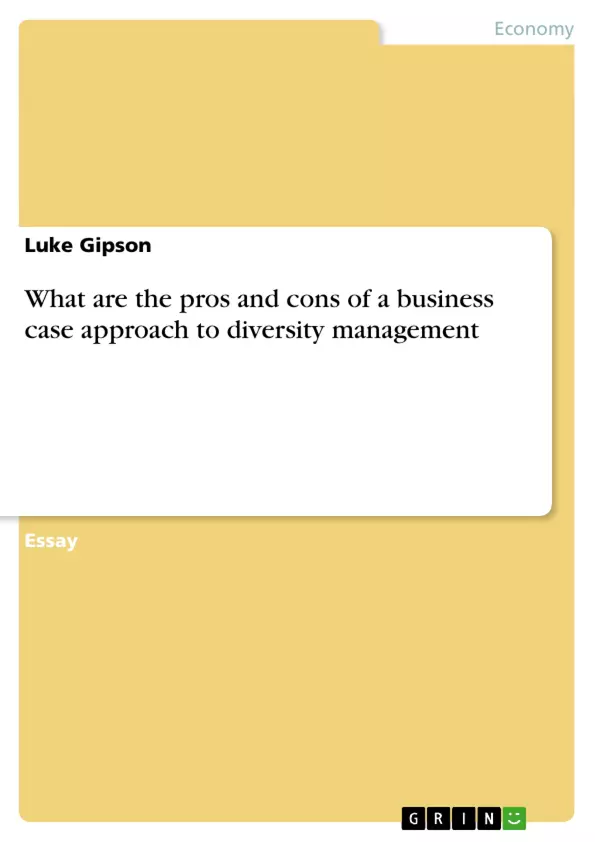In 1950 the global human population was 2.5 billion, in 2013 it has increased to 7.2 billion and by 2050 the UN predict it will reach 9.6 billion (The Economist , 2013). Shared with the statistic that since 2011, 52.1% (United Nations, 2012) of humans live in an urban area, highlighting the need for an increased and evolved ability to manage diversity. This global trend has created the most diverse workforce in modern times, generating pressure for companies, institutions and governments to implement practices which recruit, train, promote and retain individuals within the workplace (Bratton and Gold 2012; Kirton and Greene 2010). The strategic management of diversity in the workforce will be further discussed using a three stage approach, in order to fully analyse the pros and cons of a business case approach to diversity management.
The first stage will have two discussion points; firstly defining diversity to create a common understanding of the topic. Secondly it’s important to distinguish the difference between the terms of equal opportunity and diversity management, exploring how they have evolved from academic and practical perspectives. The second stage will focus on diversity management with particular emphasis on analysing the pros and cons of a business case approach. This critique will be supported by theories and contemporary resources to highlight the impact this approach can have on the stakeholders involved. The third stage will consider the implementation and industry type. This will highlight the limitation that by splitting diversity into different case types rather than focusing on an inclusive strategy causes fragmentation rather than concentrating on the individual contribution.
Inhaltsverzeichnis (Table of Contents)
- Stage One
- Defining Diversity
- Equal Opportunity vs Diversity Management
- Stage Two
- Business Case Approach - Advantages
- Strategic Platform
- Measurable Benefits
- Practical Perspective
- Business Case Approach - Disadvantages
- Empirical Evidence
- Short-term Perspective
- Narrowness
- Stage Three
- Implementation and Industry Type
- The Importance of an Inclusive Strategy
Zielsetzung und Themenschwerpunkte (Objectives and Key Themes)
The primary objective of this paper is to analyze the benefits and drawbacks of a business case approach to diversity management within a workplace context. The paper aims to examine how diversity management has evolved from an equal opportunity perspective to a more strategic approach and explore its implications for organizations and individuals.
- Defining Diversity: Exploring the various dimensions of diversity, including surface-level and deep-level diversity.
- Equal Opportunity vs. Diversity Management: Differentiating the two approaches and highlighting their evolution from academic and practical perspectives.
- Business Case Approach to Diversity Management: Examining the advantages and disadvantages of this approach, including its potential for creating competitive advantage and its limitations in terms of short-term focus and narrowness.
- Practical Applications of Diversity Management: Analyzing real-world examples of how organizations have implemented diversity management strategies and their impact on organizational performance.
- Importance of an Inclusive Strategy: Emphasizing the need for a broader, inclusive approach to diversity management that goes beyond a purely business-focused perspective.
Zusammenfassung der Kapitel (Chapter Summaries)
Stage One introduces the concept of diversity, providing a comprehensive definition encompassing various dimensions. It also delves into the evolution of diversity management from an equal opportunity approach to a more strategic perspective. The discussion explores the academic and practical perspectives on both approaches, highlighting their strengths and limitations.
Stage Two focuses on the business case approach to diversity management. It examines the advantages of this approach, such as its ability to provide a strategic platform and quantifiable benefits. The chapter also presents real-world examples of organizations that have successfully implemented diversity management strategies using a business case approach. However, it also analyzes the potential drawbacks of this approach, such as the lack of empirical evidence for its effectiveness and its tendency towards short-term focus and narrowness.
Schlüsselwörter (Keywords)
The key terms and concepts explored in this paper include diversity management, equal opportunity, business case approach, competitive advantage, organizational performance, inclusivity, strategic planning, surface-level diversity, deep-level diversity, stakeholder engagement, and empirical research.
- Quote paper
- Luke Gipson (Author), 2013, What are the pros and cons of a business case approach to diversity management, Munich, GRIN Verlag, https://www.grin.com/document/268980



